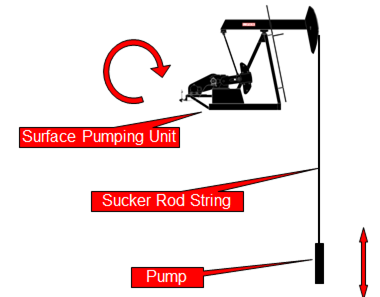Rod Pumping System is a system of artificial lift using a surface pumping unit to impart reciprocating motion to a string of rods. Rod string then extends to a positive displacement pump placed in well near producing formation. In other words, the primary function of a rod pumping system is to convert the energy supplied at the prime mover into the reciprocating motion of the pumping unit required to transmit energy through the rod pumping to the downhole pump in order to artificially lift the reservoir.
Rod Pumping System:

The rod pumping system is made up of three components:
- The surface pumping unit: which provides the means of turning the rotating power and motion of the motor into the reciprocating motion at the correct speed needed at the pump.
- The rod string: that connects the surface unit to the pump and provides the force at the pump to lift the fluid to the surface.
- The pump: which pumps the fluid to the surface.
The integrity of this pumping system is only as good as each of the links or components.
Continue reading →





